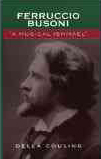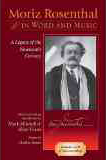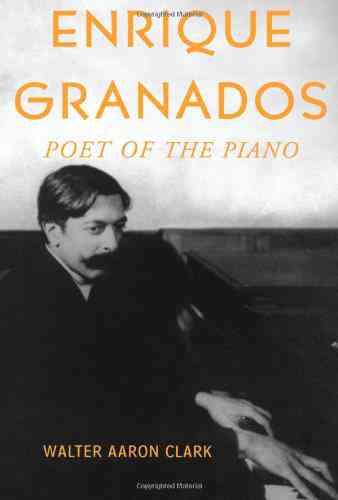

 Ferruccio Busoni: "A Musical Ishmael," by Della Couling. Lanham, Md.: Scarecrow, 2005. xvi + 390 pp. ISBN 0-8108-5142-3.
Ferruccio Busoni: "A Musical Ishmael," by Della Couling. Lanham, Md.: Scarecrow, 2005. xvi + 390 pp. ISBN 0-8108-5142-3.
Moriz Rosenthal in Word and Music: A Legacy of the Nineteenth Century, edited and with an introduction by Mark Mitchell and Allan Evans. Preface by Charles Rosen. Bloomington: Indiana University Press, 2006. xiv + 184 pp. ISBN 0-253-34660-6.
Enrique Granados: Poet of the Piano, by Walter Aaron Clark. Foreword by Alicia de Larrocha. New York: Oxford University Press, 2006. xvii + 265 pp. ISBN 0-19-514066-4.
The art of the piano in the late nineteenth century is well represented in three recent volumes, each differing greatly in approach and style. In Ferruccio Busoni: "A Musical Ishmael," Della Couling embarks on a compelling voyage that follows Busoni's every step in his itinerant and bohemian life. Moriz Rosenthal in Word and Music: A Legacy of the Nineteenth Century relies on writings by Rosenthal himself and those of some of his contemporaries to depict the personality and artistry of this "Titan of the keyboard." Finally, in Enrique Granados: Poet of the Piano, Walter Aaron Clark digs deep into the life and music of this most prolific composer and virtuoso pianist, while also exposing the reader to the richness of Spain's musical heritage.
"It was Busoni's friend, the Anglo-Dutch composer Bernard van Dieren, who astutely dubbed him 'a musical Ishmael.'" Thus opens the "Introduction" to Ferruccio Busoni: "A Musical Ishmael." With this apt comparison between the Biblical Ishmael and Ferruccio Busoni (1866-1924), Couling proceeds to elaborate on the "feeling of rootlessness" shared by the two. Like Ishmael, Busoni wandered far, never settling down in any one place for an extended period of time. He lived as a citizen of the world, moving from his native Italy to Weimar, Vienna, Graz, Trieste, Frohnleiten, Leipzig, Helsinki, Moscow, Boston, New York, Berlin, Bologna, and Zurich. This volume represents the first comprehensive biography of Busoni since Edward Dent's in 1933. Though Dent offered a full-length biographical study of Busoni, he had comparatively limited access to certain bibliographical material and faced many restrictions imposed by Busoni's widow. Couling, on the other hand, has had the benefit of numerous letters, journals and other sources that have become available since the publication of Dent's book. She tells Busoni's story in a compelling and accessible manner.
The book contains twelve chapters organized chronologically, each of which detail Busoni's life in a particular geographical location. Throughout, the reader discovers the personal and professional hardships faced by Busoni and how, through great persistence and self-determination, he succeeded in establishing himself as a pianist and composer. We learn of Busoni's dislike for his own public performing, as a result of the numerous impromptu auditions imposed upon him as a child by his father; we learn of his difficulty in keeping teaching positions, some of them quite prestigious, due to the demands of his active career as a performer; and we learn of his stable relationship with his wife, Gerda, who was the pillar of his life.
Couling also addresses Busoni's life-long difficulty in attempting to reconcile the Italian with the German (his mother was of Italo-German descent), the composer with the virtuoso pianist, and the inquisitive intellectual with the focused musician. In addition, she offers interesting accounts of meetings with luminaries such as George Bernard Shaw, Egon Petri, Arnold Shoenberg, Edgar Varèse, and Igor Stravinsky, among others. Each chapter combines concurrent biographical and compositional developments, a choice that could easily contribute to a confusing delivery of information. Yet Couling succeeds in weaving the distinct threads into a unified, engaging, and coherent whole.
Although Couling discusses several works by Busoni, she does not provide a formal analysis of any of them, although she describes the Piano Concerto and the String Quartet in D minor (BV 225) in considerable musical depth. She also elaborates on the circumstances and inspirations behind the writing of the operas Die Brautwahl and especially Doktor Faustus, his last work, offering detailed descriptions of the librettos. Accounts of reactions from the public and critics alike to premieres and performances of Busoni's own compositions contribute to diversified and interesting reading, and several photographs of Busoni, his family, friends, and of other contemporaries complete the image of the era and the personalities under discussion.
Ferruccio Busoni: "A Musical Ishmael" includes a selected list of published compositions, organized chronologically. This type of listing will not appeal to those interested in conducting quick searches of works by category, medium, or genre. The author claims that by choosing this form of listing, she hopes to demonstrate the "organic progression from one opus to the next in Busoni's composing." She does however provide a separate listing of transcriptions and editions for solo piano.
Moriz Rosenthal (1862-1946) was another influential pianist of the late nineteenth century who enthralled audiences and critics alike for decades through flashy displays of virtuosity, but also through sensitive artistry and a legendary legato touch. Rosenthal, like Busoni and other prominent musicians of the time, possessed high erudition, vast cultural breadth, and often found writing to be an effective means for expressing his philosophical ideas. In conceiving Moriz Rosenthal in Word and Music: A Legacy of the Nineteenth Century, Mark Mitchell and Allan Evans compiled writings by Rosenthal himself and short essays by his contemporaries, such as Eduard Hanslick, Arthur Johnstone, Kaikhosru Sorabji, and Edward Prime-Stevenson, among others. Mitchell and Evans concentrated their attention on Rosenthal's writings never previously published nor translated into English, thus providing the reader with new insights into the life and mind of this remarkable artist.
From a pianist's point of view, perhaps the most valuable gift of Moriz Rosenthal in Word and Music: A Legacy of the Nineteenth Century is the compact disc recording of Rosenthal's own performances that accompanies the volume. Rosenthal began recording only after his sixty-fifth year, and this disc shows the technical and artistic range of this legendary pianist. The wide spectrum of colors that Rosenthal manages to draw from the piano is both astonishing and inspiring. The CD includes previously unreleased performances of Chopin-Liszt's My Joys and the Finale of Chopin's Sonata No. 3 in B minor, Op. 58. Additional works by Chopin, Schubert, Schubert-Liszt, and Strauss-Rosenthal round out this historical gem.
Moriz Rosenthal in Word and Music: A Legacy of the Nineteenth Century begins with a preface by Charles Rosen, who studied with both Rosenthal and his wife, Hedwig Kanner-Rosenthal, in New York City. Rosen communicates his veneration for Rosenthal's playing, specifically addressing his technique, tone color, understanding of the musical structure, pedaling, rubato, and, of course, unforgettable cantabile and legatissimo touch. Rosen includes an account of Rosenthal's famous meeting with Johannes Brahms, correcting the version told in the New Grove Dictionary of Music and Musicians, which according to Rosen is "inaccurate." He also comments on the humorous aspects of Rosenthal's personality.
In the brief chronology and introduction, Mark Mitchell and Allan Evans provide the reader with essential biographical information, without which the remaining essays in the book could not be contextualized. Whereas the chronology lists Rosenthal's musical studies and performances according to date, the introduction discusses Rosenthal's training, his intellectual development, pianistic style, writings, and personality traits, particularly his sharp wit. The authors based their narrative on excerpts from "lessons" on interpretation that Rosenthal wrote for Etude magazine, and on letters and other writings from the period.
The book continues with a brief autobiography in which Rosenthal recalls events in his life through 1876. His writing flows easily, and a strong sense of narrative humor and wit prevail. He admits his admiration for Napoleon Bonaparte, often writing as though he is the general himself. This section also contains items of historical interest; for instance, Rosenthal presents remarkable insight into how Chopin's elders perceived the pianist's style, offers his opinion on the "scale inferno" (the pros and cons of practicing scales for four hours each day, as prescribed by one of his teachers in Vienna), and refers to the subtle differences between the touches of half-staccato, portato and jeu perlé, distinctions lost to many of today's pianists. Rosenthal makes extensive references to his family, who supported and encouraged him from the start, and indulges the reader with tales of his earlier years as a piano student under different teachers.
Additional material written by Rosenthal includes letters, thoughts on music, composers, and performers, and memories of meetings with Ferruccio Busoni and Johannes Brahms. Contributions from other authors consist mostly of reviews of Rosenthal's performances. The delightful appendix A portrays Rosenthal as a humorist, and includes many of his engaging quips. Appendix B, an annotated concertography, gives the reader an idea of the vastness of Rosenthal's repertoire, while appendix C consists of a discography of released and private recordings. In addition to providing the reader with biographical information, Moriz Rosenthal in Word and Music: A Legacy of the Nineteenth Century immerses the reader in the rich intellectual environment in which Rosenthal lived. Sadly, it also makes one realize that his endless quest for knowledge, which seemed to be the norm at the time, is now exceptional.
Enrique Granados: Poet of the Piano by Walter Aaron Clark is the first detailed scholarly biography of Enrique Granados (1867-1916) in the English language. Clark, who previously attained international acclaim with a biography of the Spaniard Isaac Albeniz, offers a compelling, thoroughly researched, well-conceived, and insightful biography of Albeniz' fellow countryman, Granados. A brief foreword by Spanish pianist Alicia de Larrocha endorses Clark's work without reservation.
In the introduction, Clark provides the reader with a brief historical overview of nineteenth-century Spain, describing its historical, social, political, and economic unrest. He relates how in the late nineteenth century Barcelona became an increasingly powerful industrial and commercial center, and how this prosperity brought about a cultural renaissance, the Spanish Renaixença. This conservative current, which pursued the revival of Catalan culture, literature, and language, preceded and then coexisted with the progressive Catalan Modernist movement, the Spanish counterpart of Art Noveau. Barcelona thus became home to both futurists and conservatives, and its industrial bourgeoisie became the nest from which most Spanish artists, architects, and writers evolved. It was in this cultural environment that Enrique Granados lived.
After a brief discussion of Granados' family background and early years as a pianist, the reader is introduced to Granados the composer. Though a Catalan by birth, Granados and his music exhibit the versatility of "a citizen of Europe." As he stated: "I consider myself to be as Catalan as anyone, but in my music I wish to express what I feel, what I admire and what is attractive to me, whether it be Andalusian or Chinese." Clark successfully addresses this range of compositional versatility by devoting chapters to groups of works either belonging to the same time period or sharing similar musical characteristics. He devotes substantial space to Goya's influence on Granados, including a thorough analysis of Goyescas for piano and a detailed discussion of Goyescas the opera. Clark also provides a great deal of information regarding the influence of Spanish folk music and dance on Granados' output.
In addition to the music itself, Clark also enlightens readers on Granados' activities as a teacher, conductor, organizer, and promoter of Catalan modernisme. The book concludes with two compelling discussions: one that details the successful premiere of the opera Goyescas in New York City and the fateful return voyage to Spain in which Granados and his wife perished; the second that assesses the legacy of Granados as an artist, and provides a much deserved tribute. Clark asserts that though Granados never achieved the stature of a Beethoven or a Chopin, his music is unique and undoubtedly influenced subsequent generations of Spanish composers. A teacher, his legacy rests upon the numerous pupils he instructed, some of whom became quite known and influential, and as a performer, his musical gifts survive through his extant piano-roll recordings.
Enrique Granados: Poet of the Piano also contains a genealogy and a comprehensive list of published, unpublished and unfinished works, organized by category. This biography, extensively researched, brilliantly conceived, and masterfully written will appeal to anyone with an interest in Granados, his music, piano music in general, and the history of Spanish music. It exemplifies musicological scholarship and research of the highest caliber.


